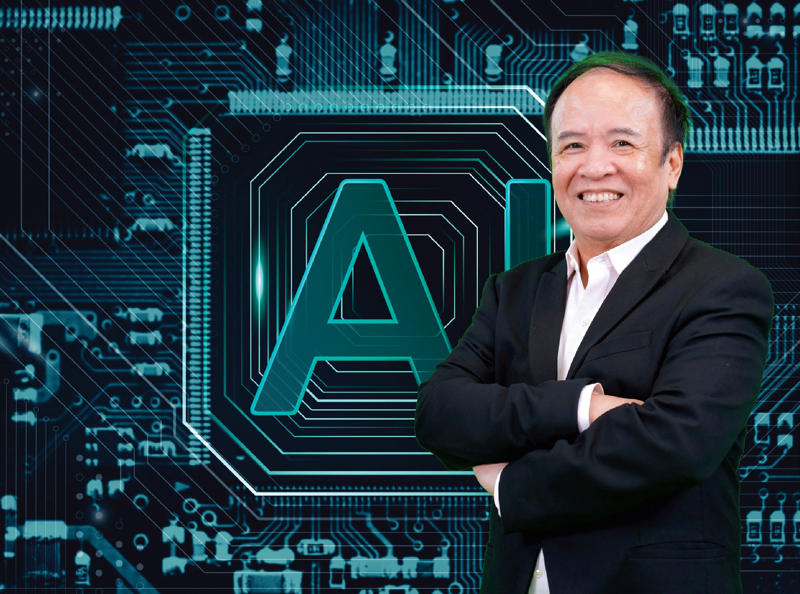In order to develop “Made in Vietnam” AI, the country will need to rely heavily on its domestic science and technology resources. How would you assess its current talent pool?
Vietnam’s science and technology industry boasts many strengths, but to envision future growth it is important to analyze existing weaknesses. We must confront the reality, while also building on our strengths.
Vietnam has a substantial team of scientists. However, they grew up in a challenging environment, which limited their ability to fully apply their knowledge. That said, this generation is deeply passionate about science and technology, with strong expertise in fundamental disciplines. The main limitation lies in their application-oriented thinking, which is not as adaptive as that of today’s younger generation.
Younger Vietnamese who have studied in the US, Europe, Japan, and beyond bring diverse perspectives and exposure to modern technologies. Many excel in applying technology and have worked in global firms like Google and Microsoft. However, their weakness is a lack of systemic organization. Many work individually, and when returning to Vietnam, some shift to other fields like business.
In general, our science and technology workforce still falls short of the breakthrough demands of today’s economy. The core issues lie in mechanisms, policy, organization, and how talent is utilized.
In terms of utilizing talent, how can Vietnam attract international AI experts and overseas Vietnamese to contribute to national tech development?
Attracting external talent is possible, but the real challenge is building strong internal capacity. Only with that strength can we truly engage global experts. We need a capable local team that can absorb, collaborate with, and build upon the knowledge of overseas and international talent.
In some areas, we already have strong scientists, but in many, we lack sufficient human resources. To attract top talent, Vietnam could offer flexible visa and work permit policies, and support long-term, meaningful projects. With strong research topics, good policies, and proper funding, talent will come. But ultimately, the key is developing strong domestic capabilities.
How can Vietnam build strong internal capacity in AI?
I believe we need to implement several key measures in parallel to drive real change.
First, science and technology should be directed towards resolving socio-economic problems. This is a key lesson from past generations.
Second, we need to review and adjust existing mechanisms and frameworks to foster science and technology development. This includes enhancing public-private collaboration, allowing businesses to access university and research institute facilities, and vice-versa, to apply science in industry and daily life. Mechanisms and frameworks related to international cooperation are also very important. Vietnam should welcome global experts and create favorable conditions for top talent to work or teach at our universities.
Third is the issue of organizational structure. Many research institutes today operate inefficiently and only at a minimal level. Talented researchers often leave for better opportunities, and those who stay may focus only on short-term, superficial results. Without long-term commitment and application, impactful results are hard to achieve. This is a troubling reality.
Fourth, we must invest in developing human resources in science and technology. This is a long-term task, but it’s fundamental for sustainability. Unfortunately, our current curricula and training methods remain outdated and disconnected from future needs.
These four areas are, in my view, the core issues. Many other challenges exist, but addressing these would lay a strong foundation.
What steps should Vietnam take to build a data foundation for AI, in addition to leveraging its resources?
Data is the key to AI development. Without data, AI cannot function. In Vietnam, data is currently the most significant bottleneck. It is fragmented and scattered across different organizations and units, with no connection between them, rendering it nearly useless. Data, by itself, is just numbers. A single number doesn’t convey much, but when combined with many others, it reflects specific information. And that information is the “gold mine”.
Moreover, data has not yet been recognized as a resource to be fully exploited. Some data protection policies are still rigid, fearing leaks or violations of privacy. For example, collecting human DNA data raises concerns about privacy. But if done systematically with clear regulations, data protection can be ensured. We can delete or anonymize sensitive personal information like names, replacing them with encrypted codes. In this way, data can still be used without risk.
What are your thoughts on the growing trend of collaboration between Vietnamese AI companies and global tech giants?
I see this as an important issue. But the fundamental point is that we must have real value to collaborate. This means having our own market, mechanisms, and policies in place.
This goes back to the first point: a comprehensive design, which means knowing exactly the problems we need to resolve, the macro policies, and the general direction for Vietnamese society. Only then can we present our problem to international corporations and collaborate with them to resolve exactly what we need to.
Is strategic orientation and cooperation to build a support network crucial for driving AI and technology development?
Exactly. We must treat science and technology as a national issue, not an individual one. To resolve a national issue, we need to coordinate many factors and implement specific and feasible projects, not vague ones like “AI research”.
If we invest $10 billion over 5-10 years without measurable results, how can we assess success? Hence, the problem must be clear, and if it’s not achieved, it’s a failure. If the goal is vaguely stated as “AI development”, then any result will be seen as a “success”, but repeating such successes will only lead to setbacks.
China has achieved major AI breakthroughs like DeepSeek. What can Vietnam learn from that case?
The key lies in long-term recognition of science and technology as a national driver. China recognized the strategic role of science and technology more than 20 years before we did.
In Vietnam, we have only recently formalized this vision through Politburo Resolution No. 57-NQ/TW, dated December 22, 2024, which affirms the importance of science and technology for sustainable national development. It’s a promising start, but I believe we still haven’t fully internalized its urgency.
AI, as a part of this ecosystem, is interconnected with various sectors. Without such an overarching vision, we risk staying reactive and fragmented. Moreover, AI can only thrive when fueled by diverse datasets and real-world problems across sectors.
This comprehensive design has enabled China to make significant progress, such as with DeepSeek, even amid geopolitical challenges. In contrast, in Vietnam, each sector seems to pursue its own separate strategy. When interdisciplinary collaboration is needed, coordination can be lacking, and projects stall.
China’s science and technology development plan through 2050 is, in my view, a “masterpiece” well worth studying. In addition, China has built a robust university system and a well-structured talent pipeline, supported by effective talent attraction policies. Its strategy also involves close collaboration with major domestic companies like Alibaba and Baidu, along with strong State financial support.
These elements highlight the key features of China’s approach, and offer valuable lessons for Vietnam. Of course, we should not copy it wholesale. Our strategy must be visionary yet tailored to our specific context. But it is crucial to understand that DeepSeek was not a random success; it was the result of years of deliberate, well-structured policymaking.









 Google translate
Google translate